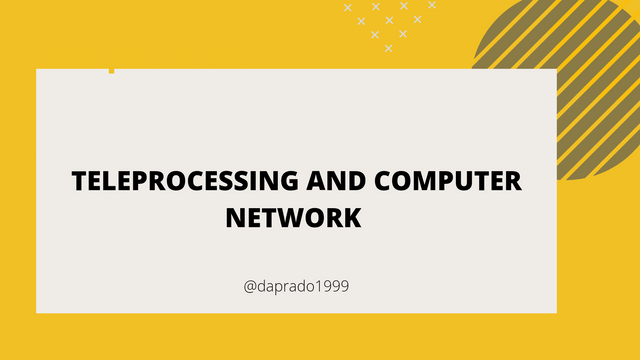
TELEPROCESSING AND COMPUTER NETWORKS
Teleprocessing refers to the basic process of facilitating data processing using telecommunication network such as telephone lines and microwave links for smooth running of the computer network system.
Proximity plays a key role in teleprocessing as several work stations can join the same computer no matter their distances apart. Even as far apart as several thousands of miles, they could be interconnected using the teleprocessing phenomenon.
Furthermore, a major practice is for the work station being microcomputer inclined synchronized with a mainframe computer via a communication network link. In view of this, the work station obtains desired information from the mainframe computers through the telecommunication link and subsequently achieving the aim of connecting several network of computers.
 source
source
Moreso, it's crucial to note that the teleprocessing is very important as it occurs especially where such network is serving a same organization to communicate easily with one another directly or through a central computer system.
On the contrary, a huge demerit is that if the central computer network server breaks down, the communication synergy between the component nodes could be bridged and therefore would not be possible to achieve.
However, a collateral damage mechanism can occur between the various component nodes even when the central computer source breaks down. Other computers at different nodes can still intercommunicate by passing information from one to the other around the virtual communication ring.
 source
source
MODES OF TELEPROCESSING IN COMPUTER NETWORK
Full Duplex Mode:
This is a teleprocessing mode observed when communication between two or more stations can transmit and receive signals simultaneously. It is more convenient to use but is exclusively costly to install and manage too.Half Duplex Mode:
This is a teleprocessing mode observed when communication between two or more stations can transmit and receive in quick succession but not simultaneously. This means one station transmits while the other station receives and vice versa when they both switch roles.Simplex Mode:
This is a teleprocessing mode observed when communication between two or more stations is decicively defined. This I mean one would be the transmitter and the other the receiver. But they never switch roles. This could be used in an open loop control system as a means of passing on control commands.
O'Leary, T.J and Williams, B. K., Computers and Information Processing (Menlo Park, Ca., Benjamin Cummings, 1985).
Petersson, J. L. and Silberschatz, A., Operating Systems Concepts, 2nd edn (Reading, Mass, Addison-Wesley, 1985)
You are a member of #club5050 but you have used the wring tags in this post. Kindly, pay attention to your correct tags. Thanks.
Downvoting a post can decrease pending rewards and make it less visible. Common reasons:
Submit
🎉🎉🎉Congratulations !!!🎉🎉🎉
Your post being nominated for BOOMING support. Improve the quality of your posts and keep the original work.
Please read the following guide:
Guidlines Booming Support | Steem-Database
Downvoting a post can decrease pending rewards and make it less visible. Common reasons:
Submit
@pojan thanks for acknowledgement. I would put in more effort too.
Downvoting a post can decrease pending rewards and make it less visible. Common reasons:
Submit